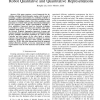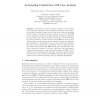313 search results - page 60 / 63 » Lazy Abstraction with Interpolants |
TASLP
2008
14 years 11 months ago
2008
Abstract--Motivated by potential applications in second-language pedagogy, we present a novel approach to using articulatory information to improve automatic detection of typical p...
104
click to vote
TFS
2008
14 years 11 months ago
2008
Abstract-- This paper proposes a novel framework for describing articulated robot kinematics motion with the goal of providing a unified representation by combining symbolic or qua...
ICFEM
2010
Springer
14 years 10 months ago
2010
Springer
Abstract. Coinduction is a major technique employed to prove behavioral properties of systems, such as behavioral equivalence. Its automation is highly desirable, despite the fact ...
MIG
2010
Springer
14 years 10 months ago
2010
Springer
Abstract. Motion blending is a popular motion synthesis technique which interpolates similar motion examples according to blending weighs parameterizing high-level characteristics ...
115
click to vote
NECO
2010
14 years 10 months ago
2010
Abstract: Reservoir Computing (RC) systems are powerful models for online computations on input sequences. They consist of a memoryless readout neuron which is trained on top of a ...



